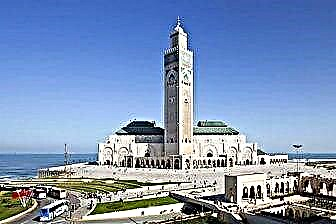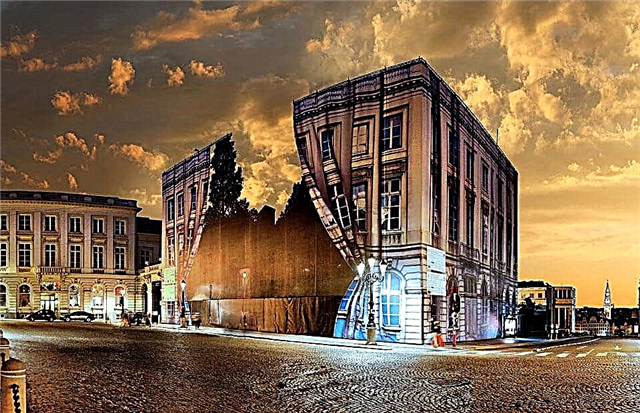Brussels is the capital with a calm and measured life. And even if this country is not on everyone's lips, like, for example, the Czech Republic or France, there is also something to see here. The sights of Brussels are varied. Historical and cultural centers, natural and man-made parks, temples and squares, scientific, culinary and thematic museums, famous monuments and libraries - any tourist will find a suitable place to visit. There are no huge traffic jams here. There are quite a lot of tourists, but you can approach every significant place without long queues and dense crowds. There are many tourist centers in this city, where they can suggest a route to the most interesting places. But even without outside help, any tourist will be able to pave the way for himself to the sights of interest to him, because there are a lot of them here and for every taste.
Atomium

The Atomium monument, which is an enlarged copy of the iron molecule, has become a real symbol of the Belgian capital. It was erected in 1958 for the World Exhibition and served as the main pavilion, symbolizes the endless possibilities of man, speaks of the need to use atomic energy for peaceful purposes. The author of the project is Andre Waterkein. The monument consists of nine huge spheres - iron atoms, whose diameter is eighteen meters.
The spheres are connected to each other using pipes. Each of the spheres performs a specific function - the one located at the highest point is the observation deck of the city, the multi-colored sphere is a small cozy hotel, the central sphere is given over to a cafe. The individual areas are exhibition halls and galleries.
Critics were divided into two camps - for some, the Atomium seems almost ugly, for others - a real work of art. In 2013, he was named the world's most bizarre building by an American channel. But the Belgians themselves are very fond of this attraction. You can get there by metro, Heizel station.
Park "Mini-Europe"
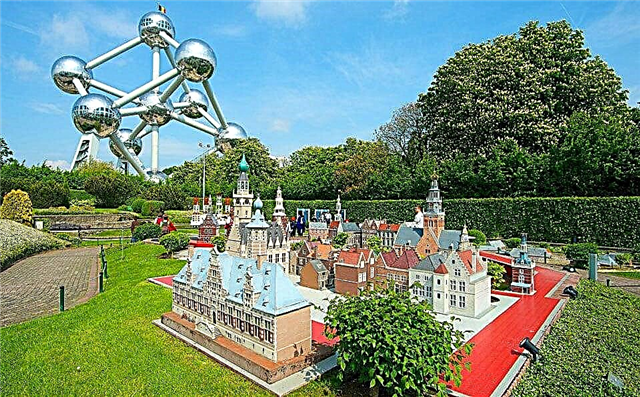
Near the Atomium you can find a very interesting Mini-Europe park. Its size is 24 thousand square meters, and on this small area there are iconic places of 80 European cities in miniature. The park was built in 1989 and has not lost its popularity to this day. Indeed, in a few hours here you can see more than 350 temples, museums, castles, towers, fragments of streets of various European cities. Each miniature is worked out in detail, and the accuracy is simply amazing.
For added interest, many layouts are accompanied by cognitive sound effects. For example, by pressing a button, you can hear the national anthem, ringing of bells or an iconic song. Also, some models present to the attention of mini-shows: a miniature Vesuvius erupts, miniature gondolas float around Venice, trains and cars ride, mills wave their blades, etc. The layout is conceived so that the tourist does not miss a single layout. Also, the miniatures are arranged in accordance with the real map: the path begins in Denmark, and ends in Spain and Portugal.
Basilica of the Sacre Coeur

This basilica is known far beyond the borders of the country, because it is one of the tallest buildings in the world, made in the art deco style. Its dimensions - 141 by 107 meters - are truly impressive. Such a large-scale building was also built on a large scale. The basilica was laid in 1905, for the 75th anniversary of the country, and the construction was completed only in 1970.
The first foundation stone was laid by King Leopold II. He loved Paris very much, so he wanted to make Brussels look like the capital of France. Because of this love for another country, and also because of the construction of almost a hundred years, the basilica was built with a mixture of architectural styles. This is now one of the building's advantages.
It is interesting not only for its history. Inside the temple there is an exhibition as well as a large collection of treasures. For example, in the very heart of the Sacre-Coeur, above the altar, there is a painting by Georges Mine, depicting Jesus giving a blessing. The basilica has 9 chapels, which is symbolic of the number of provinces in Belgium. An observation deck is also open. If you climb under the dome and take your binoculars with you, you can see not only the city and rural views, but even see Antwerp.
Town hall

The town hall has been preserved in almost every ancient city, but it is used rather as a branch of the museum. In Brussels, the 15th century town hall is still in operation, and the city administration is located there. Of course, part of the administration sits in a newer building, but the very fact that the course of history has not changed the purpose of the town hall should delight tourists.
What else is interesting about this town hall? Firstly, this is the last building of the Middle Ages, which has been preserved in the main square of the city. All others are either destroyed or rebuilt. Secondly, it is a fine example of Gothic architecture. Lovers of this architectural direction will have something to consider.
Sculptures deserve special mention. At the very top is a five-meter-high statue of Archangel Michael. The saint seems to be guarding the square, and the whole city. Also, the town hall is decorated with statues of famous citizens of the past centuries (nobles and saints). There are 137 of these statues, but now only copies can be seen on the town hall itself, and real sculptures are kept in the city museum.
Big market

In another way, this place is called the Grand Place or Grote Markt. One of the most popular places. It is not for nothing that the square is called a market square - in the past centuries there were shopping arcades here, and nowadays the famous Christmas fair is held on the square. There are many other attractions around. Of the most famous are the 15th century Gothic Town Hall, which has survived to our times, and the Bread House (or the King's House, as the French call it). In addition, six guild buildings are built around, all of them are made in different styles.
In 1971, a huge floral carpet was made here for the first time. Since then, it has become an annual tradition. You can see the beauty in the summer, in the middle of August. The event attracts many curious tourists. There is something to admire here even at night. Light shows are periodically arranged on the facades, which are best observed at night. The market square is the tourist heart of the city. There are many different hotels, cafes, restaurants and souvenir shops around it.
Cocoa and Chocolate Museum
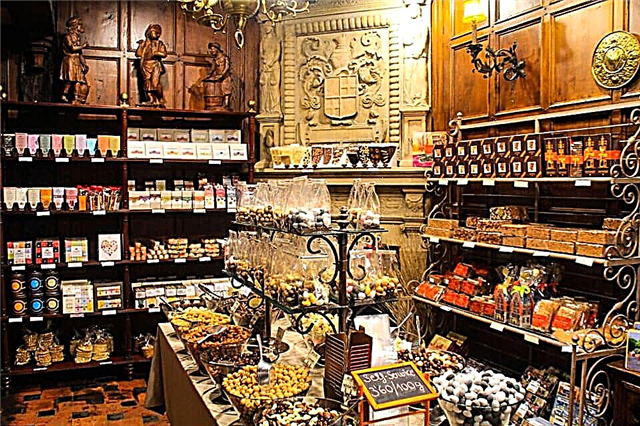
It invites visitors to learn about the history of the creation of a delicious product, as well as taste it and even participate in the creation of chocolate themselves. The exposition is very interesting and extensive; it occupies two floors. Here you can find out how cocoa beans were used throughout the existence of civilization, what technologies for making chocolate exist. All this is not just in words or pictures, but is shown on detailed posters and diagrams.
A very interesting part of the exhibition, which presents chocolate products. Those with a sweet tooth can see large sculptures, chocolate figurines, all kinds of sweets and bars. This place is very popular with tourists from all over the world. This is not surprising. The first chocolates were invented in Brussels, how can you ignore this fact? A visit will allow you to touch the history and even become a part of it by attending a master class and preparing several chocolate products on your own.
Pissing boy
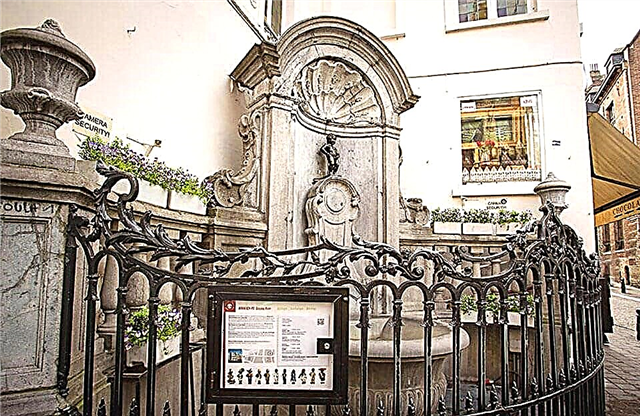
Who in the world has not heard of the famous Manneken Pis? Probably, this is not only the most famous fountain in the city, but also in the world. The famous sculpture was born thanks to Jerome Duquesnoy and has been decorating the city since 1619.Manneken Pis is a sculpture of a chubby naked toddler peeing directly into a fountain.
The height of the statue is only 61 centimeters, but tourists have to look at it from the bottom up. The Manneken Pis stands on a pedestal, the fountain itself is fenced in so that tourists do not harm the sculpture. The boy does not always stand naked. The statue is often dressed up in costumes for various occasions. The process of changing outfits has become a favorite tradition of residents. The entire collection of his clothes can be viewed in the City Museum. There are over 900 Manneken Pis clothing on display.
Monument to Charles Buls

The monument is an image of an elderly man and his dog and is dedicated to the mayor of the city Charles Buls. This man has long been remembered by the townspeople for his virtues. Charles Buls advocated the preservation of the historical view of the city center - Grand Place, while King Leopold II really wanted to transform it. Mayor Büls allocated money for the restoration of historic buildings in the market square. Largely thanks to him, the modern center of Brussels now looks just great.
Among the blessings, one can also note the desire to introduce bilingualism. During the time of this mayor, police officers were required to speak Dutch and French, and all signs in the city were duplicated in two languages. The monument is also notable for the fact that grateful residents built it at their own expense. The state did not allocate money for this, the Brussels people collected everything themselves.
Mountain of Arts
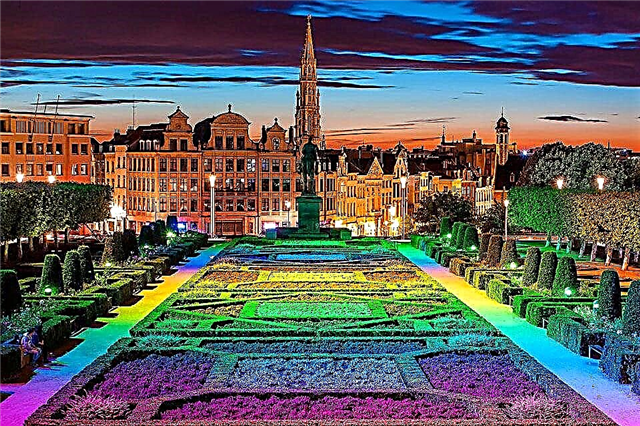
This interesting place is also called the Hill of Arts and the Hill of Mont des Ar. It used to be a densely populated area, but then the buildings were demolished, the land was empty for many years. Finally, a garden was planted here, several new buildings were erected, and an observation deck was located between them. To get your bearings, you need to understand that the Mountain of Arts is located between the Royal Palace and the Parliament building. You can climb this hill using a beautiful staircase with fountains. On the hill itself there are several important art museums, in fact, that's why the place got its name.
Visiting the Mountain of Arts, you can visit several of the most important sights at once. In this place, you can combine a walk in a picturesque park, a trip to museums and contemplation of the views of the city. In clear weather, the hill overlooks the Sacre Coeur Basilica and the Atomium. The Mountain of Arts is interesting to visit not only during the day. At night, most of the objects on it are highlighted, everything shimmers in different colors.
Cathedral Saint-Michel-et-Gudul
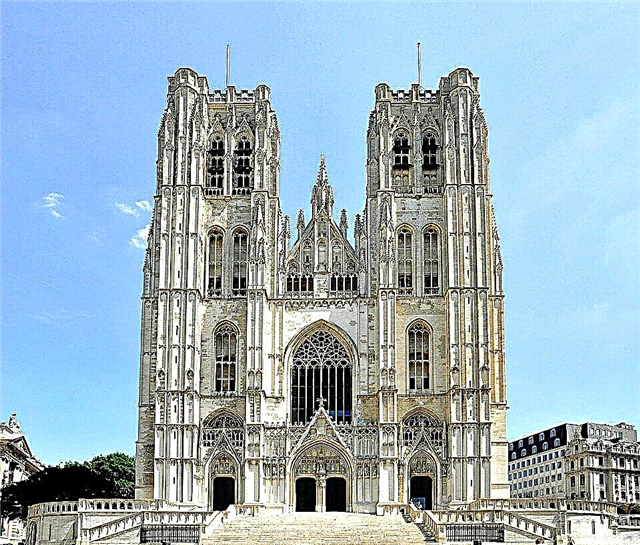
This truly majestic and stunning cathedral is as rich in history as it is impressive in appearance. It was built for several centuries: it was founded in 1225, but the construction was completed only in the 15th century. The cathedral is dedicated to Saint Michael and Saint Gudula - the patrons of Brussels, and it is named after them. Many famous architects worked on its decoration. Thus, the façade with a staircase and two identical towers 69 meters high were designed by Jean van Ruisbruck. And bright realistic stained glass windows were created by Bernard Van Orly.
The interior is very rich. In addition to the outstanding stained glass windows, there are many stunning sculptures representing kings and saints. For example, in the north transept you can see statues of Louis II and Mary. Be sure to check out the Chapel of the Holy Communion. Saint-Michel-et-Gudule, so named in the French manner, makes a person feel like a grain of sand in this vast universe. Under the stone vaults of the cathedral, you can feel the greatness of God.
Palace of Karl of Lorraine

Karl of Lorraine is a renowned philanthropist and governor-general of the Austrian Netherlands. He built his palace to his taste, taking into account the fashion trends of his time. The result is a very interesting neoclassical building that is still admired by lovers of antiquity. Inside the palace there are many architectural finds of interest to visitors.
In the ceremonial hall, you can see a star with 28 beams, each of which is lined with different types of marble. The lobby has attractive bas-reliefs showing the four elements. Inside, there are also impressive massive marble and wood staircases. The main detail is the sculpture of Hercules, which was sculpted by Laurent Delvaux. Currently, it is a museum of everyday life and art of the 18th century.
Here you can see not only sculptures and bas-reliefs, but also household items of aristocrats of past centuries. Cutlery, silverware, rare Chinese porcelain sets, musical instruments, palanquins over the beds - this place contains many interior details. Unfortunately, in 1794 the palace was robbed by looters. Therefore, most of the treasures that were stored inside are lost to us forever. Only a few rooms are intact.
Royal square

The most famous of the historic squares, the Royal Square was founded in the 18th century. It was built on the site of the burnt palace of the King of Belgium. Currently, there are many attractions around the Royal Square - the monument to Gottfried of Bouillon, the central park, the Royal Palace, the Church of St. James.
It has a typical look for the squares of French cities, because it was built by analogy with the squares of Paris. It is surrounded by other important neoclassical buildings. Getting into its center, you feel all the greatness and power of the buildings of the past centuries. It is not for nothing that the Royal Square bears this name. On the one hand, it houses the Royal Palace, which is often occupied by the current royal family. On the other hand, many official state ceremonies took place in this place.
A couple of hundred years ago, Napoleon was honored here, the accession to the throne of King William I and the inauguration of the Dukes of Brabant were celebrated. The first king of Belgium as an independent state, Leopold I, was sworn in here. The most important celebration held here is the celebration of the twenty-fifth anniversary of the reign of the first king. It was a lavish celebration that remained in the memory of the Belgians.
Royal Palace

The magnificent old building is surrounded by other equally interesting buildings of the neoclassical style. There is a small park in front of the palace. With all this beauty, the Royal Palace is the most popular location for photo shoots. It is called royal for a reason. It is currently the seat of the royal family.
If the national flag hangs from the roof, then the monarch is now in the palace. So walks near the Royal Palace give tourists a chance to contemplate a real royal person at least out of the corner of their eye. It is good to walk around the palace in pleasant weather and imagine that you are in the past. Also, every day at half past three in the afternoon, you can watch the solemn changing of the guard of honor.
Bellevue Museum

This place is interesting in four aspects at once: external and internal decoration, opening view and its basements. Externally, the building is executed in the classical baroque style. Lovers of architecture can study in detail such details of the palace as a balustrade, decorative garlands, cornices. Various sculptures and flowerpots deserve special mention. The building was erected according to a complicated construction plan for a reason: kings lived here, and in one of the rooms Princess Josephine Charlotte was even born.
The interior decoration of the house is currently occupied by three floors of expositions. Bellevue provides a chance to learn more about the history of the country. Walking through the floors, you can learn about all the events that happened in the country during its existence as a separate state, in chronological order. At the same time, the rooms have preserved the original furniture and interior items of past centuries.
The views from the terrace are truly magnificent. The Mountain of Arts and Brussels Park can be clearly seen.There is also a view of the winter garden that grows under the windows of the palace. It is not for nothing that this place is called Bellevue, which means "beautiful view". It is noteworthy that only in Bellevue you can see the original foundation of the palace of past centuries. The building was erected on the site of the burnt-out palace of Charles V, and the same foundation can be seen live. In the same basements, exhibits discovered during excavations are exhibited.
Royal Library of Belgium

It is located on the Mountain of Arts and is the center of the literary and academic monuments of Belgium. The library is a reference, which means that the books in it are not handed out - they can only be read in the halls. You need to visit this place for several reasons. Firstly, the Royal Library is the oldest in all of Europe, so such an iconic place is a must-see. The Belgians affectionately call her Albertina in honor of King Albert I, whose monument is located nearby.
Secondly, it is a very interesting place. The collection of books for the library began in the 15th century, and now the collection has become truly grandiose. The library has about 8 million printed publications, including many medieval manuscripts and manuscripts. A distinctive feature of the library is that it contains copies of all books written and published in the country, as well as books printed abroad by the Belgians.
It will be interesting to visit the unusual departments of the library, for example, the numismatic department, where you can look at old coins and even weights for weighing money. There is also a book museum open, which you must also go to.
Royal Museums of Fine Arts

The largest number of rare exhibits is presented here. To get acquainted with the entire collection, it will take at least a whole day. Otherwise, it will not be possible to carefully study the paintings of such famous artists as Peter Rubens, Anthony Van Dyck and others. After all, the exhibition features more than 20,000 works of art.
Fine arts are presented in more than one museum - here they are a whole union. It includes the Rene Magritte Museum, as well as several buildings that display the art of individual centuries - old, modern (XIX-XX centuries) and the end of the XIX century. There are also two more branches dedicated to artists such as Constantin Meunier and Antoine Wirtz.
The world level of the exhibitions is confirmed by the fact that a large number of exhibits were brought from the Louvre. In addition to paintings, you can also find sculptures and other objects of art. There are a lot of interesting specimens here, including old ones, preserved from the 18th century.
Rene Magritte Museum
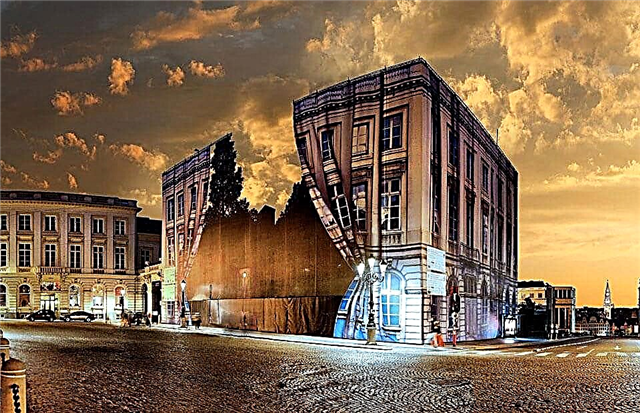
Be sure to visit the museum of renowned Belgian surrealist Rene Magritte. You can buy a separate ticket or go through the common for all the Royal Museums of Fine Arts. The collection includes as many as 200 original paintings by the author. This is the largest exhibition of works by René Magritte in the world. Most of the exhibits were collected with the help of private collectors. In addition to the paintings themselves, you can see many other things related to the work of the master.
For example, Rene Magritte shot surreal films, and you can watch them. In addition, the exhibition presents the artist's experiments in sculpture and photography, sketches and sketches of his works. The building itself also attracts the glances of passers-by. The usual gray façade is covered with a bright canvas, on which the curtain of another world seems to be slightly opened. And a visit to the Rene Magritte Museum gives you a chance to actually look into another world, to look at things in a different way, to allow thoughts to materialize.
Musical Instrument Museum

This place will be ideal for music lovers and those who know how to play any musical instrument. The gallery of musical instruments includes almost all types of them - there are keyboards, winds, percussion, electronic, and even mechanical instruments. Visitors will be shown ancient and modern exhibits. In total, more than 9000 musical instruments are presented to the audience.
Different types of instruments are located on different floors. So there will definitely be no confusion due to the abundance of exhibits. It is worth noting that the exhibition contains interactive recordings of the sound of the instruments. The exposition especially reflects the story of Adolph Sachs, because he is from Belgium. Here you can learn about how he lived and what contribution he made to the history of music. You can also see the musical instruments he created.
The museum is not limited to just one exhibition. How can you just look at the tools? You still need to listen to them live somewhere. Therefore, there is a branch in a separate building where the concert hall is located. So tourists can not only study the history of musical instruments, but also get acquainted with their sound.
Church of Our Lady of Victory on Sablon
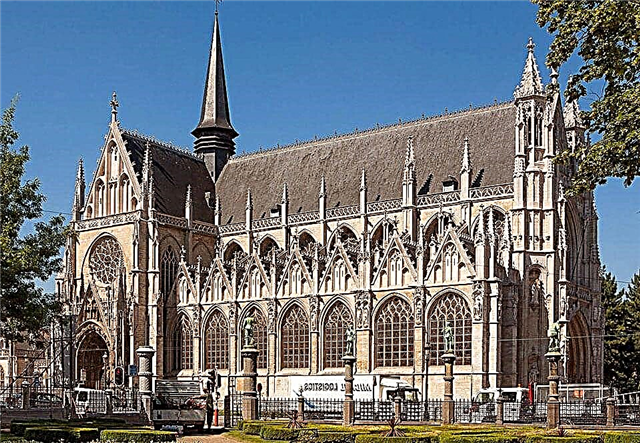
In the French manner, this temple is called Notre-Dame-du-Sablon and in many ways resembles the famous Parisian church. It was built in the 15th century in the Gothic style, as evidenced by the rose windows and sharp spiers of the towers. The church is famous for the fact that among its Catholic parishioners there are not only ordinary people, but also members of the royal family. Many Belgian nobles also come here. The history of the royal family is closely related to this temple. For example, there are burials of kings here, they are located in the chapel of St. Ursula.
Lovers of architecture should also visit it. At first glance, the unsightly grayish-white facade transforms at night: the illumination of numerous stained-glass windows makes the appearance of this temple truly fabulous. Two chapels were built, they are made in the Baroque style. Each is decorated with rare funerary symbols carved into marble. Also in the temple there is a sculpture depicting the Virgin Mary. This work of art has an interesting history - it was stolen in Antwerp and brought to the capital in 1348.
Great synagogue
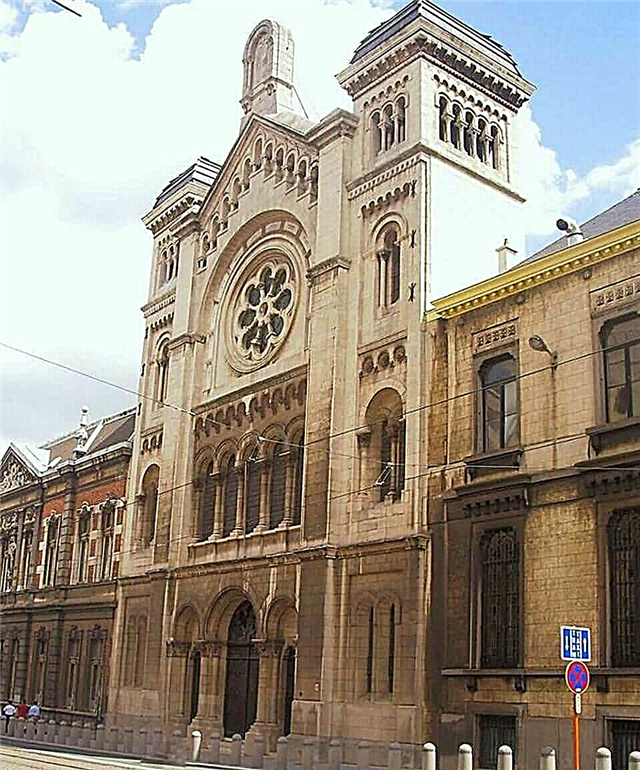
Located in the very center. It was built in 1878 by the architect Desir de Kaiser. The synagogue is made in the Romanesque style, its central part consists of three floors, and towers are built on the edges of four floors. All together looks very luxurious. The history of the synagogue is marked by sad events. The building survived the Holocaust, during which about 25 thousand Belgian Jews were killed. In 1982, a man armed with a machine gun attacked the temple and wounded four innocent people.
It is the main synagogue in Europe and actively works as the center of the Jewish community. Inside the synagogue are the headquarters of some organizations, for example, the Jewish community of the capital, as well as the central Jewish consistory.
Palace of Justice
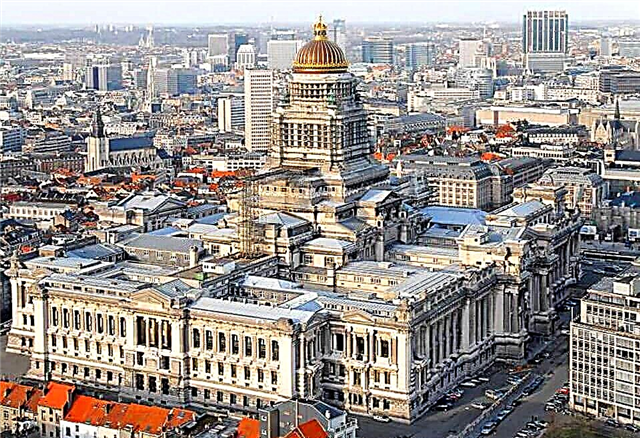
The Palace of Justice stands on a hill with a suitable name - "gallows", because here earlier justice was administered and the perpetrators were executed. The history of the creation of such a seemingly important structure is strange. Firstly, for the sake of the construction of the Palace, more than 3 thousand houses in which people lived were demolished. Secondly, a lot of money was spent on the construction. King Leopold II wanted to build a unique building, and therefore spent the state treasury on it.
And in the end, when, after 20 years, the construction was completed, the residents desecrated the built Palace and for a long time after that they scolded the architect. Despite all the obstacles, the building was completed and now it is a must-see attraction. The Palace of Justice is called so for a reason. At present, the country's cassation chamber is located inside the premises, as well as 27 court rooms.
The architect was Joseph Poulart. He erected a building in a style that combines eclecticism and Assyro-Babylonian direction at the same time. The Palace itself is an unsightly gray in color, but adorned with a stately golden dome. The Palace of Justice is three times taller than the Royal Palace, so it is visible from afar.
Halleport
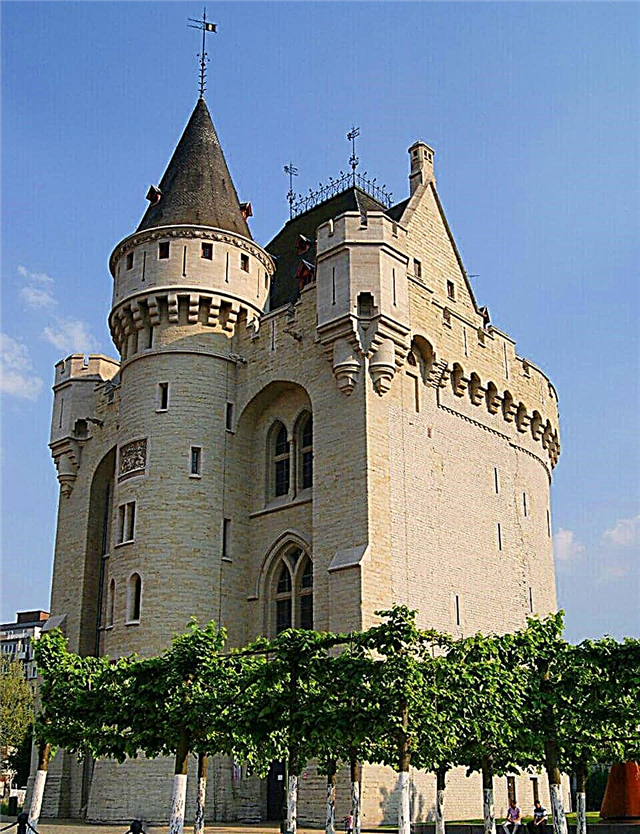
For several centuries, the capital was surrounded by an eight-kilometer fortress wall. In the course of historical events, it gradually collapsed, until in 1810 Emperor Napoleon Bonaparte ordered to demolish it completely. However, the wall was not completely destroyed. Several interesting structures remained from it, one of which is Halleport, or Port de Hal. This is the city gate, which was built in the XIV century and has survived to this day.
The two names indicate that Halleport was used not only by the Belgians, but also by the French. In the 19th century, he managed to visit a military prison. But already in 1847 it was decided to preserve the unique piece of architecture and make a museum out of it. For this, Halleport was adorned with towers and statues. Currently, inside you can see several historical exhibitions dedicated to both the history of Halleport itself and the entire city as a whole. There is an interesting exhibition of medieval weapons and armor, a Gothic hall, and an observation deck at the very top, allowing you to admire the surroundings.
Church of Our Lady of Chapelle

The Church of Our Lady of Chapelle, or Notre Dame de la Chapelle, is one of the most interesting churches in the city. Firstly, this is the oldest church in the capital of Belgium, it was built back in 1134 and has survived to our time with not so many changes. So, the tower of the church was demolished. Secondly, it is located near the Marolle quarter. The famous artist Pieter Bruegel the elder lived there. Currently, his remains are buried in this church.
It is also worth visiting because it contains several important shrines for Christians. So, in 1240, a particle of the Crucifixion of Jesus Christ appeared in the temple. Now the church also houses a font from 1475, as well as a pulpit made of wood with the image of Elijah the Prophet. This department was created in the 18th century.
European Parliament Buildings Complex
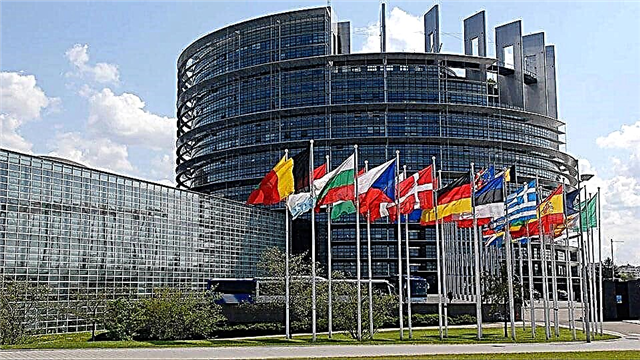
In addition to ancient historical sights, you can also find modern buildings of interest to tourists. For example, the buildings of the European Parliament, in which the real history of our time is taking place. The main building of the European Parliament is the largest building in the capital and can be seen from anywhere in the city. It was built on the site of the railway station, which was demolished in the 19th century. Now a futuristic building of glass and concrete rises here, and a rare tourist can pass by such a sight.
The architecture is very interesting. It has the shape of a wing, and in the center there is an unfinished tower, which symbolizes only a part of the countries that have joined the European Union. Apparently, when all countries join it, the tower will be completed. Any tourist can go to the European Parliament building for an excursion. And for especially curious lovers of politics, the entrance to the sessions themselves, which take place inside the parliament, is open.
St. James Church on Coudenberg Hill
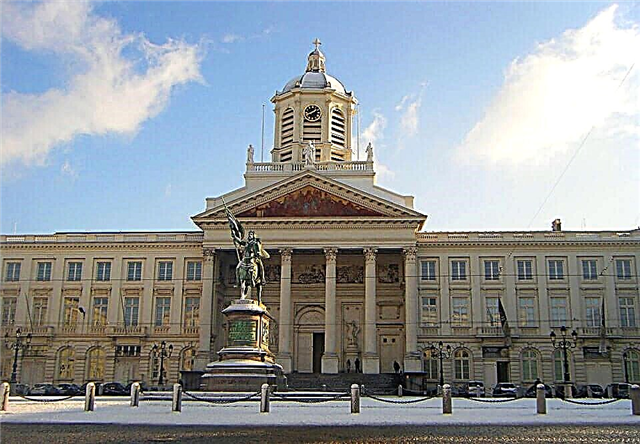
Located on one side of the Royal Square. There are eight palace buildings here, and therefore it is difficult to understand that there is also a church here, so much it merges with them. This church was built in the XII century, and then rebuilt many times. It was originally a small chapel built by the Dukes of Brabant. It became a church after the construction of a palace nearby. In 1579, a fire broke out in the country with a violent storm, and the church was practically destroyed. After that, it was restored, but significantly changed.
In front of the church there is a monument to Gottfried Boullonskum, the king of Jerusalem, who led the first crusade. His patron was exactly Saint James, after whom the church was named. Saint James protects the pilgrims. The interior is pretty simple. But her fame arose for another reason. Firstly, the first king of Belgium, Leopold I, was sworn in here. And secondly, now this church is the official church. Armed forces of the country.
Comic book museum

Recently, comics have become popular all over the world thanks to successful film adaptations. But this museum is well worth a visit for those who know more than just the Marvel and DC universes. For example, the famous Smurfs also became known to everyone from comics. And they came up with these characters in Belgium. Located in a historic building, built in 1906. The house was designed by the famous architect Victor Orta. So a tourist will be able to combine two useful activities at once - to get acquainted with the culture of comics and examine a historical monument.
In addition to the Smurfs, the country is still famous for such a hero as Tintin. In 2011, a cartoon was released about him, and even became popular. At the comic book exhibition, you will be able to get acquainted with the original manuscripts and sketches of comics, see more than 200 drawings made by artists from Belgium and France, and view reconstructions of some scenes from cartoons and comics.
Museum of Natural Sciences
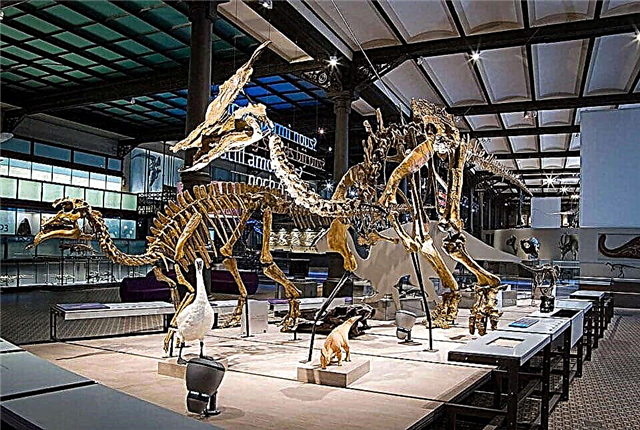
There are museums of natural sciences, probably, in every major capital. Most often it is an exhibition of stuffed animals covered with dust and moths. But in Brussels, the museum is very modern. You can safely go here with your children and not be afraid that they will get bored. Because besides the exhibition, there are many interactive moments. The most interesting is the paleontological department. Several iguanodon dinosaurs are on display here. Their height reaches 10 meters. Moreover, this is practically a whole family - they were all found during excavations of a coal mine in Hainaut in 1878.
Iguanodons are involved in interactive simulation. You can not just look at them, but find out what happened to them. Tourists can watch how the dinosaurs were covered by a landslide, most likely how they died. In addition, you can watch several videos in different languages. These videos tell about the achievements of modern paleontology.
Fiftieth Anniversary Park
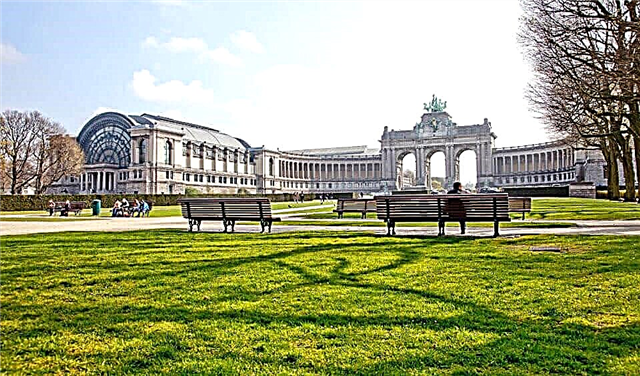
The city has several majestic and beautiful parks in which both citizens and tourists can rest. And the best of them is the park, built in honor of the fiftieth anniversary of Belgian independence. The park has a very unusual shape - several buildings have been built in it, which together form the silhouette of a horseshoe, and in its center there is a triumphal arch. The park was built in 1880, when the National Exhibition was held in the country, and only the arch was erected later, in 1905.
The park has everything for different types of recreation. It houses several interesting museums dedicated to cars, military history, and painting. As many as 30 hectares are occupied by beautiful paths, shady gardens, picturesque waterfalls and other natural beauties. Previously, various exhibitions and fairs were held here, but since the 30s of the XX century, all this was canceled and the park was turned into a place for recreation of the townspeople.
Horta Museum
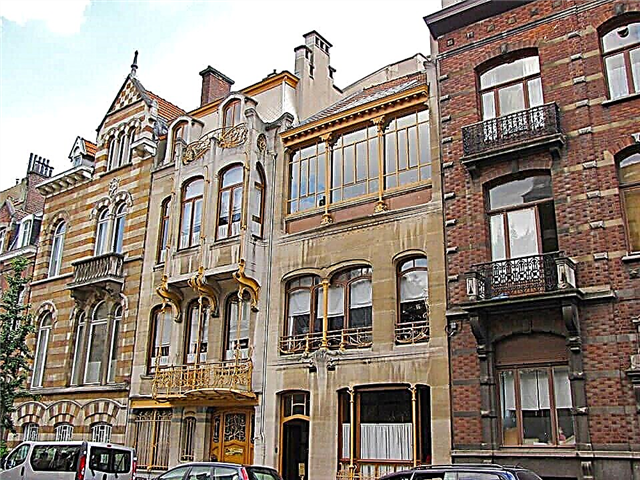
Victor Orth is a world famous architect who lived and worked in Brussels. Here he designed and erected four unique buildings recognized by UNESCO as architectural monuments. Among them is his house-workshop, which is where the museum is currently located. The architect worked in the Art Nouveau or Art Nouveau style. It is in this style that the museum itself is made. Inside, the interiors in the same style have been preserved, as well as the architect's household items, which he used during his lifetime.
In addition to the usual decor objects in the house, you can see unique designer pieces of furniture that Victor Ort created himself. Not only the permanent exhibition is on display. It is worth visiting this place for the sake of various exhibitions held here. Most often they are associated with various aspects of Viktor Horta's activities.
Leopold Park
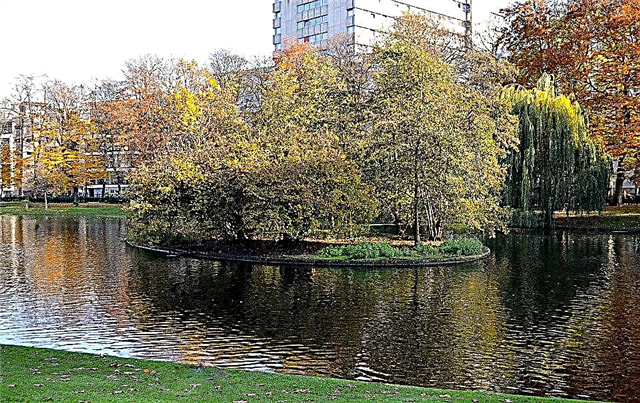
After walking along the stone streets of Brussels, sometimes you really want to see a little greenery and nature. Therefore, after visiting the building of the European Parliament, you can go to Leopold Park, fortunately, it is located very close. This park was founded in 1880 on the site of the former Royal Zoo. Its territory is 10 hectares. Of course, this park is smaller than the Fiftieth Park, but no less beautiful. There are many picturesque meadows, shady trees, ponds with ducks and fish.
In Leopolda Park, you can take a break from the bustle of the city and feed, for example, numerous birds. In addition to ducks, you can also see swans and Egyptian geese on the ponds. Among the trees in some places there are aviaries with parrots, which will be of interest to children. Architecture lovers will find many historic buildings in this park. For example, in Leopold Park, such premises have been preserved as the Solvay School of Commerce or the Belgian Institute of Natural Sciences.









